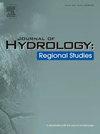一种实用的基于cnn耦合双路径LSTM网络的多步水质指数预测时间迁移学习模型
IF 5
2区 地球科学
Q1 WATER RESOURCES
引用次数: 0
摘要
研究区域:马来西亚巴生河。本研究提出了巴生河水质指数(WQI)预测框架,以解决数据缺失和季节性水文模式变化等持续存在的挑战。通过将一维卷积神经网络(CNN)与双路径长短期记忆(LSTM)网络相结合,开发了一种混合深度学习架构,以捕获长期水文记忆和特定地点的时间变异性。为了增强在数据稀缺环境中的适应性,该架构结合了迁移学习,允许从历史水质(WQ)数据中获得的知识有效地应用于当前条件,以进行稳健的预测。对区域WQI时间序列的新的水文认识往往是不完整的,并且表现出非线性的相互依赖性,这对准确预测WQI构成了重大挑战。CNN-LSTM模型有效提取参数间特征并学习时间模式,实现了较强的提前五步预测性能。尽管存在数据缺失和非平稳WQ模式等挑战,但双路径LSTM调优方法可以有效地从历史记录中转移和微调知识,从而提高跨不同时间域的预测精度。该模型保持MAPE低于5 %,KGE值在0.36和0.67之间,显示出多步WQI预测的稳健性能。这些结果突出了WQI通过捕获热带季风集水区的季节性流量动态和污染物输送来支持区域WQ评估的潜力,从而加强了WQI在河流分类和水管理中的作用,特别是在数据稀缺的条件下。本文章由计算机程序翻译,如有差异,请以英文原文为准。
A practical temporal transfer learning model for multi-step water quality index forecasting using A CNN-coupled dual-path LSTM network
Study region
Klang River, Malaysia.
Study focus
This study presents a multi-step ahead water quality index (WQI) forecasting framework in Klang River to address persistent challenges such as missing data and seasonally variable hydrological patterns. A hybrid deep learning architecture was developed by combining a 1d-Convolutional Neural Network (CNN) with a dual-path Long Short-Term Memory (LSTM) network to capture long-term hydrological memory and site-specific temporal variability. To enhance adaptability in data-scarce environments, the architecture incorporates transfer learning, allowing knowledge from historical water quality (WQ) data to be effectively applied to current conditions for robust forecasting.
New hydrological insights for the region
WQ time series are often incomplete and exhibit non-linear interdependencies, which pose significant challenges for accurate WQI forecasting. The CNN-LSTM model effectively extracts inter-parameter features and learns temporal patterns, achieving strong five-step ahead forecasting performance. Despite challenges like missing data and non-stationary WQ patterns, the dual-path LSTM tuning approach effectively transfers and fine-tunes knowledge from historical records to improve prediction accuracy across different temporal domains. The model maintains a MAPE below 5 % and KGE values between 0.36 and 0.67, demonstrating robust performance in multi-step WQI forecasting. These results highlight its potential to support regional WQ assessments by capturing seasonal flow dynamics and pollutant transports in tropical monsoon catchments, thereby reinforcing the role of WQI in river classification and water management, especially under data-scarce conditions.
求助全文
通过发布文献求助,成功后即可免费获取论文全文。
去求助
来源期刊

Journal of Hydrology-Regional Studies
Earth and Planetary Sciences-Earth and Planetary Sciences (miscellaneous)
CiteScore
6.70
自引率
8.50%
发文量
284
审稿时长
60 days
期刊介绍:
Journal of Hydrology: Regional Studies publishes original research papers enhancing the science of hydrology and aiming at region-specific problems, past and future conditions, analysis, review and solutions. The journal particularly welcomes research papers that deliver new insights into region-specific hydrological processes and responses to changing conditions, as well as contributions that incorporate interdisciplinarity and translational science.
 求助内容:
求助内容: 应助结果提醒方式:
应助结果提醒方式:


